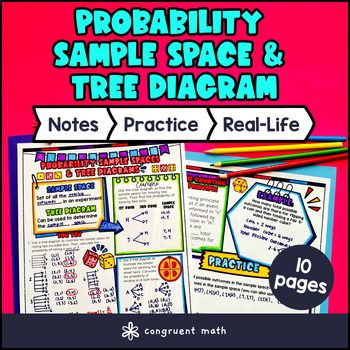Want more ideas and freebies?
Get my free resource library with digital & print activities—plus tips over email.
Join for free resources →
$4.25
Ever wondered how to teach Probability Sample Space & Tree Diagrams in an engaging way to your 7th-grade students? In this lesson plan, students will learn about compound events and their real-life applications. Through artistic, interactive guided notes, check for understanding, a doodle & color by number activity, and a maze worksheet, students will gain a comprehensive understanding of probability compound events sample space & tree diagrams. The lesson concludes with a real-life example that explores how probability is used in everyday situations.

$4.25
After this lesson, students will be able to:
Before this lesson, students should be familiar with:
As a hook, ask students why understanding probability is important in everyday life. Refer to the real-life math application page provided in the resource for ideas. For example, you can ask students why it's important to know the probability of winning a game or the chances of certain events happening.
Use the first page of the guided notes to introduce the concept of sample space. Explain that the sample space is the set of all possible outcomes of an event. Walk through the key points of sample space, such as how to list all the possible outcomes for a given event and introduce the use of tree diagrams to find probabilities of compound events.
Explain that a list and a tree diagram can be used to organize the possible outcomes of a compound event when the outcomes are not equally likely. Walk through the key points of using lists, such as how to create a list of possible outcomes and how to determine the probability of an event using the list. Refer to the FAQ section below for ideas on how to respond to common student questions.
If your class has a wide range of proficiency levels, you can pull out students for reteaching on specific concepts covered in the introduction. For more advanced students, they can begin working on the practice exercises provided in the resource (pg. 2).
Have students practice finding probabilities of compound events using the practice worksheet (pg. 2 of guided notes) provided in the Probability Guided Notes & Doodles resource. Walk around to answer student questions.
Fast finishers can dive into the maze activity (pg. 3 of guided notes) or color by number worksheet (pg. 4 of guided notes) included in the resource for extra practice. You can assign it as homework for the remainder of the class.
Use the last page of the guided notes to bring the class back together, and introduce the concept of real-life applications of probability and sample space. Explain to the students that probability is not just a theoretical concept, but it has practical uses in our daily lives.
One example of a real-life application of probability is in weather forecasting. Weather forecasters use probability to predict the chances of rain, snow, or other weather conditions. They use historical data, current weather patterns, and complex mathematical models to calculate the likelihood of different weather events happening. By understanding probability, they can provide us with accurate forecasts that help us plan our activities.
Another example is in the field of medicine. Doctors and researchers use probability to assess the effectiveness of treatments and determine the likelihood of certain conditions or diseases occurring. For example, when testing new drugs, they use statistical methods to analyze data and determine the probability of a drug being successful in treating a particular disease.
Probability is also used in sports. Coaches and athletes use probability to analyze their opponents' strategies and make informed decisions during games. For example, in basketball, coaches may analyze the shooting percentages of their opponents to plan defensive strategies. In football, coaches may use probability to calculate the likelihood of certain plays being successful.
Real-life applications of probability are not limited to these examples. Probability is used in various fields, such as finance, engineering, marketing, and more. Understanding probability and sample space can help us make informed decisions and better understand the world around us.
Refer to the FAQ section of this resource for more ideas on how to teach the real-life applications of probability to your students.
A fun, no-prep way to practice probability of simple events is Doodle Math — they’re a fresh take on color by number or color by code. It includes multiple levels levels of practice, perfect for a review day or sub plan.
Here are some activities to try:
If you’re looking for digital practice for probability of simple events, try my Pixel Art activities in Google Sheets. Every answer is automatically checked, and correct answers unlock parts of a mystery picture. It’s incredibly fun, and a powerful tool for differentiation.
Here's an activity to explore:
In probability, a sample space is the set of all possible outcomes of a random experiment or event.
To create a sample space for a compound event, list all the possible outcomes of each individual event and combine them to create a list of all possible outcomes for the compound event.
A tree diagram is a visual tool used to organize and display all the possible outcomes of a random experiment. It is especially helpful for analyzing compound events.
To construct a tree diagram for compound events:
The fundamental counting principle states that if there are m ways to do one thing and n ways to do another thing, then there are m * n ways to do both things.
To use the fundamental counting principle in probability:
To find the probability of a compound event, divide the number of favorable outcomes by the total number of possible outcomes.
Real-life applications of probability and sample spaces include:
Get my free resource library with digital & print activities—plus tips over email.
Join for free resources →